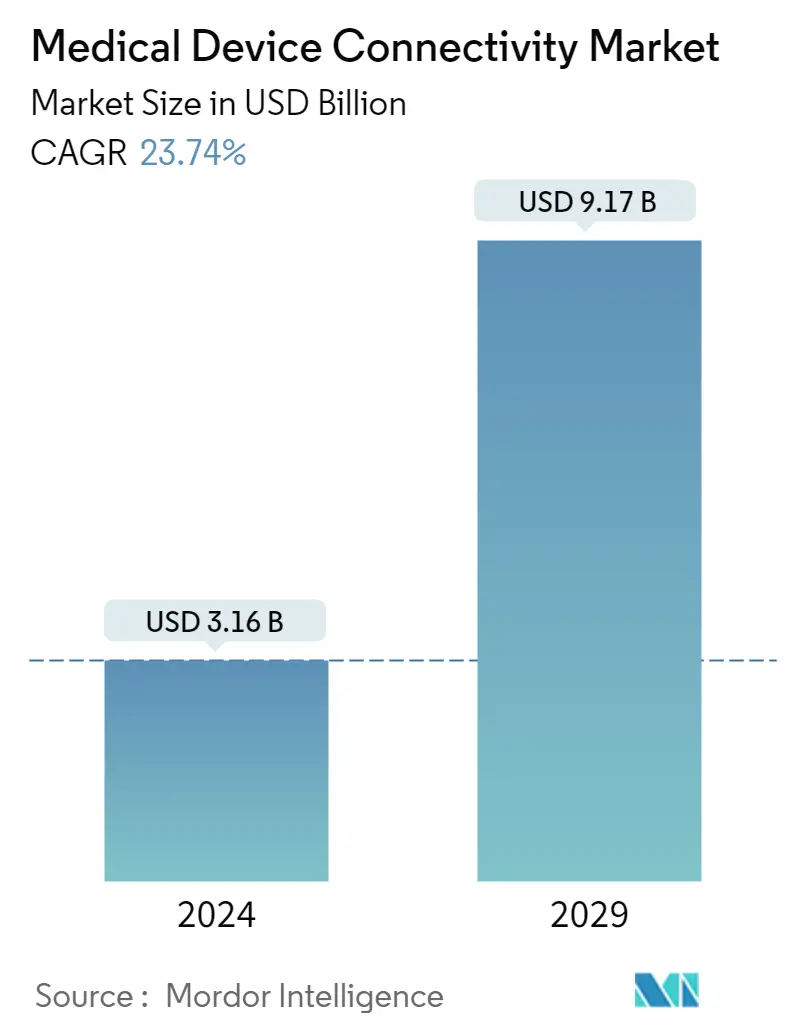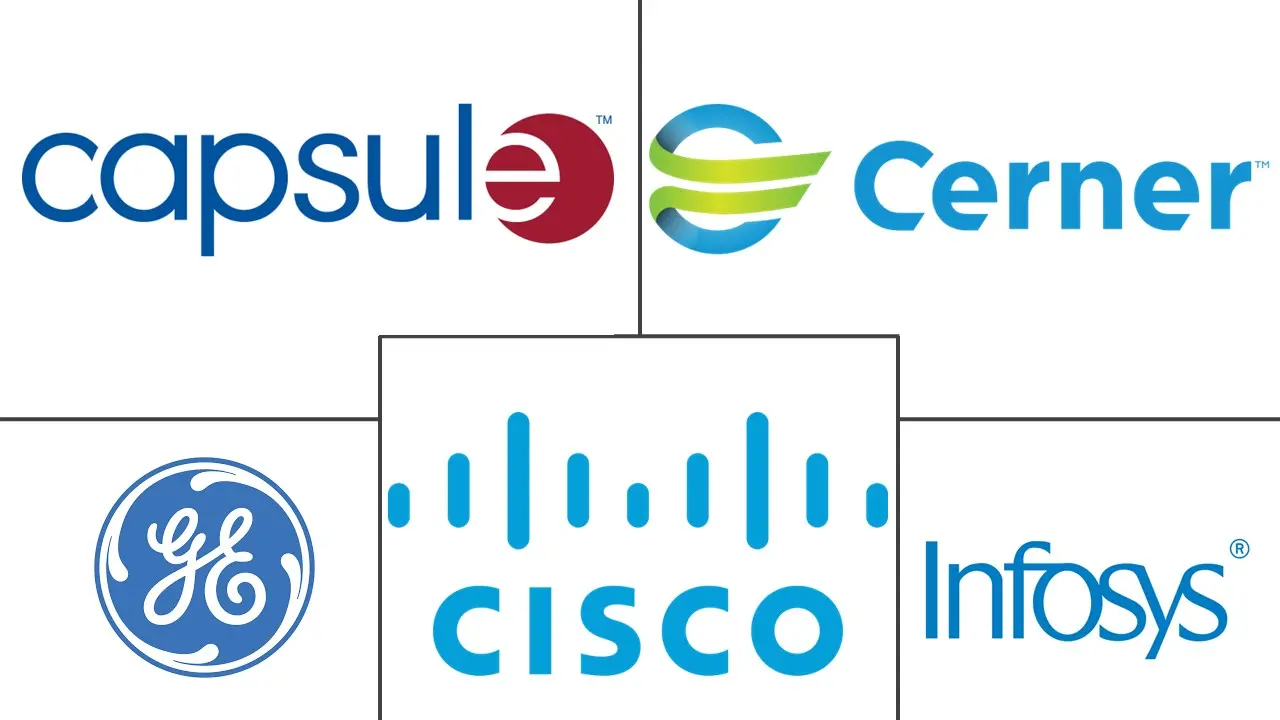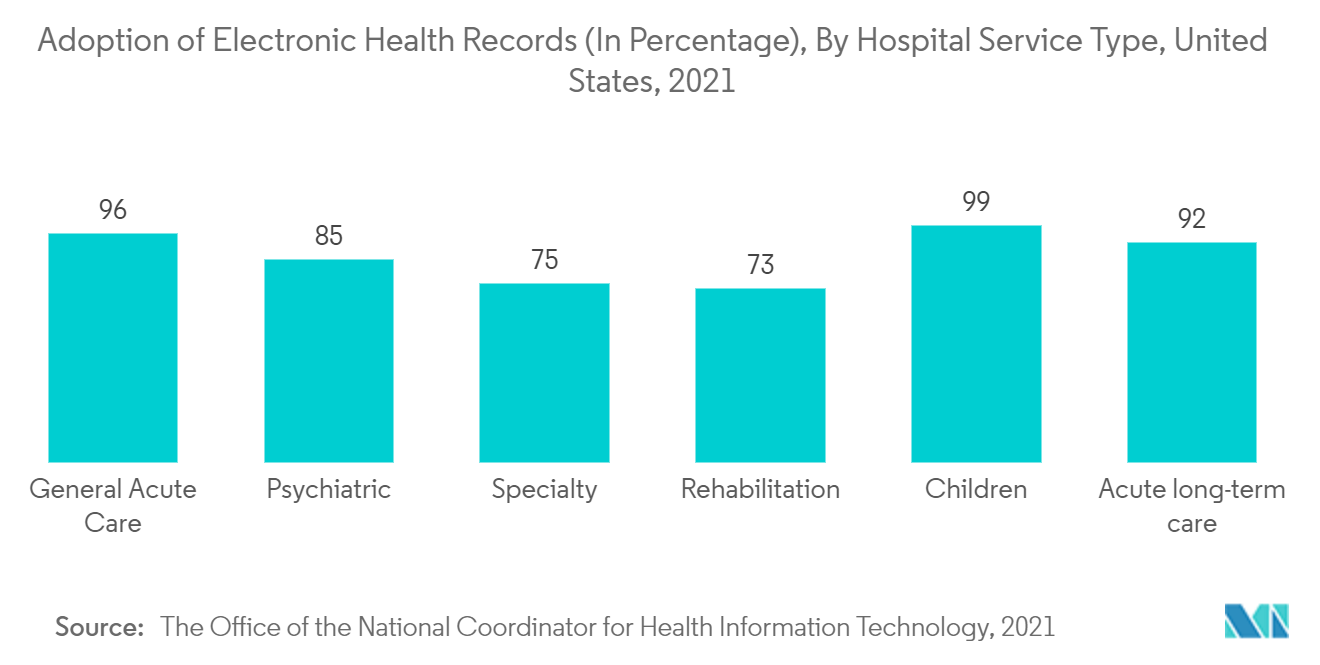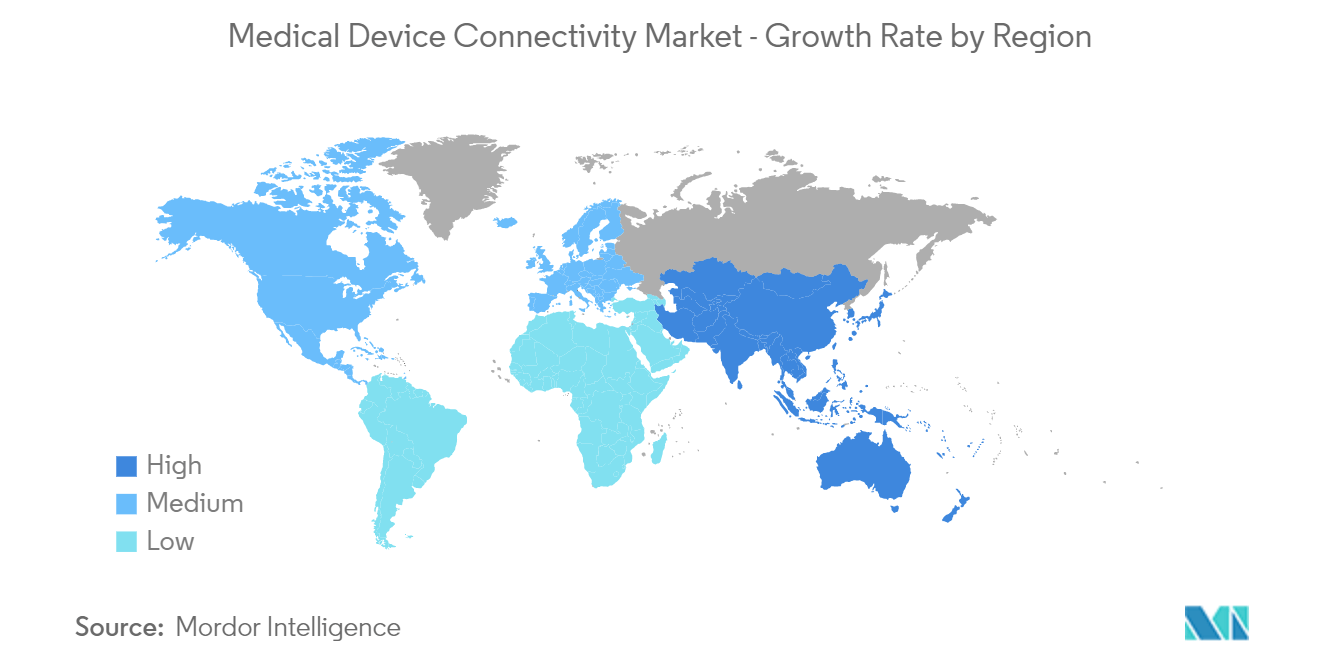Medical Device Connectivity Market Size

| Study Period | 2019 - 2029 |
| Market Size (2024) | USD 3.16 Billion |
| Market Size (2029) | USD 9.17 Billion |
| CAGR (2024 - 2029) | 23.74 % |
| Fastest Growing Market | Europe |
| Largest Market | North America |
Major Players
*Disclaimer: Major Players sorted in no particular order |
Medical Device Connectivity Market Analysis
The Medical Device Connectivity Market size is estimated at USD 3.16 billion in 2024, and is expected to reach USD 9.17 billion by 2029, growing at a CAGR of 23.74% during the forecast period (2024-2029).
Medical device connectivity is one of the industries that had a positive impact due to the COVID-19 pandemic owing to the extensive patient pool getting admitted to the hospital due to the infection. For instance, according to an article published by De Gruyter, in August 2021, Advances in the internet of medical things (IoMT) technology allow to connect of all medical tools, medical databases, and devices via the internet in one collaborative network, which conveys real-time data integration and analysis. IoMT framework-driven COVID-19 self-assessment tool captured signs and symptoms through multiple probing questions, storing the data in the COVID-19 patient database, then analyzing the data to determine whether a person needs to be tested for COVID-19 or other actions may require to be taken. Medical device connectivity system has demonstrated the ability to enhance health outcomes and reduce chaos during the pandemic, which made hospitals realize the advantage of medical device connectivity system over manual systems. Hence, the demand for medical device connectivity system systems increased, eventually driving the market growth.
The major factors for the growth of the market include the rising implementation of electronic health records and health information exchange systems, an increase in the demand for telehealth and telemedicine technologies, and technological advancements in wireless technologies and Bluetooth-enabled medical devices. For instance, according to an article published by Cox Communications, Inc., in May 2022, Bluetooth Low Energy (BLE) was developed and used Bluetooth technology to track. BLE makes use of software and gateways via cell phones and other devices. It enables low-power wireless technology, extending battery life while allowing devices to communicate with one another. The vast majority of smartphones and tablets are BLE compatible, making them perfect for closer contact. Furthermore, in September 2021, the Faculty of Sexual and Reproductive Healthcare (FSRH) and the Royal College of Obstetricians and Gynecologists (RCOG) joined forces to launch a new campaign to disseminate information about telemedicine for early medical abortion (EMA). Thus, the increasing adoption rate of telemedicine services is directly affecting the growth of the medical device connectivity market.
The companies are actively involved in new product launch developments and collaborations to expand their footprint. For instance, in October 2021, Royal Philips launched device drivers that enable integration and interoperability, Philips Capsule Medical Device Information Platform (MDIP). Philips Capsule MDIP integrated into the Philips HealthSuite Platform, installed in more than 3,000 healthcare facilities globally. Philips Capsule MDIP captures streaming clinical data and transforms it into actionable insights for patient care management, aiming to improve collaboration between care teams, streamline clinical workflows, and increase productivity. Such development is expected to drive the growth of the market over the forecast period.
Therefore, the factors mentioned above are attributed collectively to the studied market growth over the forecast period. However high cost of deployment and complete installation limiting the adoption of advanced solutions are expected to hinder market growth over the forecast period.
Medical Device Connectivity Market Trends
This section covers the major market trends shaping the Medical Device Connectivity Market according to our research experts:
Wireless Technologies Segment by Technology is Expected to Witness a Significant Growth over the Forecast Period
Wireless technology includes controlling and programming a medical device, monitoring patients remotely, or transferring patient data from the medical device to another platform, such as a cell phone. The major factors driving the growth of the market include rising technological advancements and an increase in the adoption of wireless medical device connectivity in healthcare facilities. For instance, the Radio Frequency Wireless Technology and Bluetooth Low Energy (BLE) in Medical Devices provide recommendations to develop and support safe and effective wireless medical devices. Medical device manufacturers are encouraged to read this guide and review related recognized standards and guidance documents to help in the development, testing, regulatory submission, and use of wirelessly enabled medical devices. For instance, according to the RFiD Discovery 2022, a unique device identification system for medical devices is mandated by the U.S. FDA's Unique Device Identification (UDI) Rule. This means that every medical device used in the US must be marked with a Unique Device Identifier (UDI) that can be read by both humans and machines. The demand for advanced technologies is fueling the wireless technology segment of the market.
Furthermore, the companies are actively involved in new product launch developments and collaborations to expand their footprint in the wireless technology segment. For instance, in September 2021, CareVention HealthCare launched a remote patient monitoring service that uses biosensors and artificial intelligence to monitor patients' vital signs and alert healthcare providers if necessary.
Therefore, the above-mentioned factors are expected to drive segmental growth in the market during the forecast period.

North America is Expected to hold a Significant Market Share over the Forecast Period
Medical device connectivity is a rapidly growing component of healthcare in North America due to the growing burden of chronic diseases and the high adoption of advanced healthcare technologies. The adoption of telemedicine has improved care management, patients' quality of life, and reduced healthcare spending. For instance, according to the 2021 report from the Canadian Institute of Health Information, Canadian health expenditure increased to USD 308.1 billion in 2021 compared to USD 301.5 billion in 2020. Similarly, as per the 2022 report of the Centers for Medicare and Medicaid Services (CMS), the health expenditure of the United States was about USD 4.3 trillion, an increase of about USD 173 billion from the previous year. Thus, the increasing healthcare spending is anticipated to create opportunities for telemedicine, thereby propelling market growth.
Additionally, governments and companies are engaged in innovation and initiative in the medical device connectivity market, driving growth in the forecast period. For instance, in October 2021, the FDA's Digital Health Center of Excellence (DHCoE) held a public workshop on the transparency of artificial intelligence/machine learning-enabled medical devices. The workshop followed the recently published list of nearly 350 AI/ML-enabled medical devices. The workshop was aimed at moving forward the objectives of FDA's DHCoE to 'empower stakeholders to advance healthcare by fostering responsible and high-quality digital health innovation.'
Thus, given the factors above, the telemedicine market is expected to grow significantly in North America over the forecast period.

Medical Device Connectivity Industry Overview
The medical device connectivity market is consolidated in nature due to the presence of several companies operating globally as well as regionally. The competitive landscape includes an analysis of a few international as well as local companies which hold the market shares and are well known, including Capsule Technologies, Inc., Cerner Corporation, Cisco Systems, GE Healthcare, Ihealth Lab, Infosys, Koninklijke Philips N.V., Lantronix, Inc., and NantHealth, Inc., among others.
Medical Device Connectivity Market Leaders
-
Capsule Technologies, Inc.
-
Cerner Corporation
-
Cisco Systems
-
GE Healthcare
-
Infosys Limited
*Disclaimer: Major Players sorted in no particular order

Medical Device Connectivity Market News
- July 2022: Abbott announced that it received United States Food and Drug Administration breakthrough device designation for its deep brain stimulation (DBS) system.
- March 2022: Cognosos, Inc., a leading Real-Time Location Services (RTLS) provider, launched LocationAI, a highly accurate, machine learning-powered location engine, into its asset-tracking platform for hospitals and healthcare facilities.
Medical Device Connectivity Market Report - Table of Contents
1. INTRODUCTION
- 1.1 Study Assumptions and Market Definition
- 1.2 Scope of the Study
2. RESEARCH METHODOLOGY
3. EXECUTIVE SUMMARY
4. MARKET DYNAMICS
- 4.1 Market Overview
-
4.2 Market Drivers
- 4.2.1 Rising Implementation of Electronic Health Records and Health Information Exchange Systems
- 4.2.2 Increase in the Demand for Telehealth and Telemedicine Technologies
- 4.2.3 Technological Advancements in Wireless Technologies and Bluetooth-Enabled Medical Devices
-
4.3 Market Restraints
- 4.3.1 High Cost of Deployment and Complete Installation Limiting the Adoption of Advanced Solutions
- 4.3.2 Data Privacy and Security Concerns
-
4.4 Porter Five Forces
- 4.4.1 Threat of New Entrants
- 4.4.2 Bargaining Power of Buyers/Consumers
- 4.4.3 Bargaining Power of Suppliers
- 4.4.4 Threat of Substitute Products
- 4.4.5 Intensity of Competitive Rivalry
5. MARKET SEGMENTATION
-
5.1 By Product & Service
- 5.1.1 Medical Device Connectivity Solutions
- 5.1.2 Medical Device Connectivity Services
-
5.2 By Technology
- 5.2.1 Wired Technologies
- 5.2.2 Wireless Technologies
- 5.2.3 Hybrid Technologies
-
5.3 By End User
- 5.3.1 Hospitals
- 5.3.2 Ambulatory Care Centers
- 5.3.3 Others
-
5.4 Geography
- 5.4.1 North America
- 5.4.1.1 United States
- 5.4.1.2 Canada
- 5.4.1.3 Mexico
- 5.4.2 Europe
- 5.4.2.1 Germany
- 5.4.2.2 United Kingdom
- 5.4.2.3 France
- 5.4.2.4 Italy
- 5.4.2.5 Spain
- 5.4.2.6 Rest of Europe
- 5.4.3 Asia-Pacific
- 5.4.3.1 China
- 5.4.3.2 Japan
- 5.4.3.3 India
- 5.4.3.4 Australia
- 5.4.3.5 South Korea
- 5.4.3.6 Rest of Asia-Pacific
- 5.4.4 Middle-East and Africa
- 5.4.4.1 GCC
- 5.4.4.2 South Africa
- 5.4.4.3 Rest of Middle East and Africa
- 5.4.5 South America
- 5.4.5.1 Brazil
- 5.4.5.2 Argentina
- 5.4.5.3 Rest of South America
6. COMPETITIVE LANDSCAPE
-
6.1 Company Profiles
- 6.1.1 Capsule Technologies, Inc.
- 6.1.2 Cerner Corporation
- 6.1.3 Cisco Systems
- 6.1.4 GE Healthcare
- 6.1.5 Ihealth Lab
- 6.1.6 Infosys Limited
- 6.1.7 Koninklijke Philips N.V.
- 6.1.8 Lantronix, Inc.
- 6.1.9 NantHealth, Inc.
- *List Not Exhaustive
7. MARKET OPPORTUNITIES AND FUTURE TRENDS
** Subject To AvailablityMedical Device Connectivity Industry Segmentation
As per the scope of the report, medical device connectivity is the formation and maintenance of a connection through which data is transferred between a medical device, such as a patient monitor and an information system. The Medical Device Connectivity Market is segmented by Products and Services (Medical Device Connectivity Solutions and Medical Device Connectivity Services), Technology (Wired Technologies, Wireless Technologies, and Hybrid Technologies), End User (Hospitals, Ambulatory Care Centers, and Others), and Geography (North America, Europe, Asia-Pacific, Middle East and Africa, and South America). The market report also covers the estimated market sizes and trends for 17 different countries across major regions globally. The report offers the value (in USD million) for the above segments.
| By Product & Service | Medical Device Connectivity Solutions | |
| Medical Device Connectivity Services | ||
| By Technology | Wired Technologies | |
| Wireless Technologies | ||
| Hybrid Technologies | ||
| By End User | Hospitals | |
| Ambulatory Care Centers | ||
| Others | ||
| Geography | North America | United States |
| Canada | ||
| Mexico | ||
| Geography | Europe | Germany |
| United Kingdom | ||
| France | ||
| Italy | ||
| Spain | ||
| Rest of Europe | ||
| Geography | Asia-Pacific | China |
| Japan | ||
| India | ||
| Australia | ||
| South Korea | ||
| Rest of Asia-Pacific | ||
| Geography | Middle-East and Africa | GCC |
| South Africa | ||
| Rest of Middle East and Africa | ||
| Geography | South America | Brazil |
| Argentina | ||
| Rest of South America |
Medical Device Connectivity Market Research FAQs
How big is the Medical Device Connectivity Market?
The Medical Device Connectivity Market size is expected to reach USD 3.16 billion in 2024 and grow at a CAGR of 23.74% to reach USD 9.17 billion by 2029.
What is the current Medical Device Connectivity Market size?
In 2024, the Medical Device Connectivity Market size is expected to reach USD 3.16 billion.
Who are the key players in Medical Device Connectivity Market?
Capsule Technologies, Inc., Cerner Corporation, Cisco Systems, GE Healthcare and Infosys Limited are the major companies operating in the Medical Device Connectivity Market.
Which is the fastest growing region in Medical Device Connectivity Market?
Europe is estimated to grow at the highest CAGR over the forecast period (2024-2029).
Which region has the biggest share in Medical Device Connectivity Market?
In 2024, the North America accounts for the largest market share in Medical Device Connectivity Market.
What years does this Medical Device Connectivity Market cover, and what was the market size in 2023?
In 2023, the Medical Device Connectivity Market size was estimated at USD 2.55 billion. The report covers the Medical Device Connectivity Market historical market size for years: 2019, 2020, 2021, 2022 and 2023. The report also forecasts the Medical Device Connectivity Market size for years: 2024, 2025, 2026, 2027, 2028 and 2029.
Medical Device Connectivity Solutions Industry Report
Statistics for the 2024 Medical Device Connectivity Solutions market share, size and revenue growth rate, created by Mordor Intelligence™ Industry Reports. Medical Device Connectivity Solutions analysis includes a market forecast outlook to 2029 and historical overview. Get a sample of this industry analysis as a free report PDF download.



